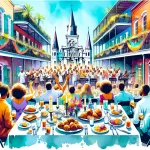Jazz funerals in New Orleans are a captivating blend of African, French, and American traditions, creating a unique celebration of life that reflects the city’s cultural heritage. These ceremonies have their roots in the gatherings of enslaved Africans in Congo Square, where they would sing, dance, and play drums during their limited free time on Sundays. As enslaved Africans were allowed to hold their own Christian burials, these funerary rituals became an opportunity to consolidate a sense of community through public performances, blending African musical traditions with European Christian practices.
In This Article
TL;DR
- Jazz funerals seamlessly intertwine African, French, and American influences into a singular celebratory event.
- Key elements include a brass band procession, transition from solemn to lively music, and the symbolic “cutting loose” of the spirit.
- Respectful participation and adherence to etiquette are crucial for attendees to honor the tradition and the grieving family.
The Ceremony Structure
Origins and Historical Significance
Jazz funerals in New Orleans have their roots in a blend of African and European traditions. The practice evolved from the gatherings of enslaved Africans in Congo Square, where they would sing, dance, and play drums during their limited free time on Sundays. These gatherings, known as “ring shouts,” are considered the birthplace of jazz music.
As enslaved Africans were allowed to hold their own Christian burials, these funerary rituals became an opportunity to consolidate a sense of community through public performances. The blending of African musical traditions with European Christian practices laid the foundation for the unique jazz funeral tradition.
Notable figures like Buddy Bolden and Jelly Roll Morton played a significant role in shaping the jazz funeral tradition in the late 19th and early 20th centuries. Their contributions helped establish the distinct sound and structure of the processions, which became an integral part of New Orleans’ cultural identity.
The Ceremony Structure
A typical jazz funeral begins with an initial gathering at a church or funeral home, where the family and loved ones of the deceased come together. The procession then commences, led by a brass band playing somber dirges or spirituals like “Nearer My God to Thee.”
As the procession moves towards the cemetery, the music gradually transitions from mournful to celebratory. The mourners, known as the “second line,” follow the brass band, often dancing and swinging their bodies to the upbeat rhythms.
At the burial site, the “cutting loose” ceremony takes place, where the spirit of the deceased is symbolically released. This is typically marked by the brass band striking up a lively tune like “When the Saints Go Marching In,” and the second line erupting into a joyous celebration of the person’s life.
The Role of Music
Brass bands are an integral part of jazz funerals, with their distinct sound guiding the emotional journey of the procession. The bands typically consist of trombones, saxophones, trumpets, tubas, and drums, creating a rich and powerful musical experience.
Common songs played during jazz funerals include “Just a Closer Walk with Thee,” “Battle Hymn of the Republic,” and “Down By the Riverside.” These songs carry deep spiritual and cultural meanings, reflecting the African American experience and the belief in the afterlife.
The music serves as a catalyst for the transformation from mourning to celebration, with the brass band’s rhythms and melodies leading the way. As the procession progresses, the music becomes more upbeat, encouraging the second line to “cut loose” and dance in honor of the deceased’s life.
Cultural and Social Impact
Jazz funerals are a reflection of New Orleans’ multicultural heritage, blending African, French, and American traditions into a unique and vibrant celebration of life. They serve as a powerful symbol of the city’s resilience and the strength of its communities.
These ceremonies play a crucial role in community bonding and healing, providing a shared experience that transcends individual grief. By participating in the procession and celebration, attendees find solace and support in the collective mourning and rejoicing.
Jazz funerals have also influenced popular culture and media, with their distinctive sights and sounds being featured in films, television shows, and music videos. This exposure has helped to preserve and spread awareness of this rich cultural tradition beyond New Orleans.
Participation and Etiquette
When attending a jazz funeral, it is important to respect the tradition and the family by following certain guidelines. Respectful attire, such as dark or muted colors, is recommended for the initial procession, while more vibrant and festive attire is appropriate for the celebratory portion.
Locals and visitors alike are encouraged to join the second line, as long as they do so respectfully and follow the lead of the brass band and experienced participants. It is important to refrain from disruptive behavior and to maintain a respectful distance from the family and close mourners.
Engaging with the event in a respectful manner is crucial, as jazz funerals are deeply rooted in the cultural traditions of New Orleans’ African American community. Attendees should be mindful of their actions and strive to honor the significance of the ceremony.
Planning Your Experience
The best times of year to witness a jazz funeral in New Orleans are typically during the spring and fall months, when the weather is more favorable for outdoor processions. However, these events can occur throughout the year, as they are an integral part of the city’s cultural fabric.
Information about upcoming jazz funerals can be found through local funeral homes, cultural organizations, or by inquiring with knowledgeable locals. It is important to respect the privacy of the family and to attend only if invited or if the event is open to the public.
When attending a jazz funeral, it is recommended to arrive early, dress appropriately, and be prepared to follow the lead of the brass band and experienced participants. Engaging with the event in a respectful and authentic manner will enhance the overall experience and appreciation for this unique cultural tradition.
Preservation and Evolution
Efforts to preserve the jazz funeral tradition are ongoing, with cultural organizations and educational institutions playing a vital role in maintaining and promoting this important aspect of New Orleans’ heritage.
Contemporary influences, such as the incorporation of hip-hop, R&B, and funk elements into the brass band performances, have helped to keep the tradition relevant and appealing to younger generations. This evolution ensures that jazz funerals remain a living and vibrant part of the city’s cultural landscape.
At the same time, there is a strong emphasis on preserving the core elements and historical significance of jazz funerals. Educational programs and community initiatives aim to pass down the knowledge and traditions to future generations, ensuring that this unique celebration of life continues to thrive in New Orleans.
Comparisons and Global Influence
While jazz funerals are a distinctly New Orleans tradition, similar practices can be found in other cultures around the world. For example, the second line processions and celebratory elements bear resemblance to certain African and Caribbean funeral traditions, reflecting the shared African diaspora roots.
The global influence of jazz funerals has also been significant, with elements of the tradition being adopted and adapted in various communities worldwide. From brass band processions to the blending of mourning and celebration, the impact of New Orleans’ jazz funerals can be seen in funeral practices across different cultures and regions.
This cross-cultural exchange and influence highlight the universal human desire to honor the deceased while celebrating the richness of life. Jazz funerals serve as a powerful reminder of the enduring connections between diverse cultures and the shared experiences that bind us together.






